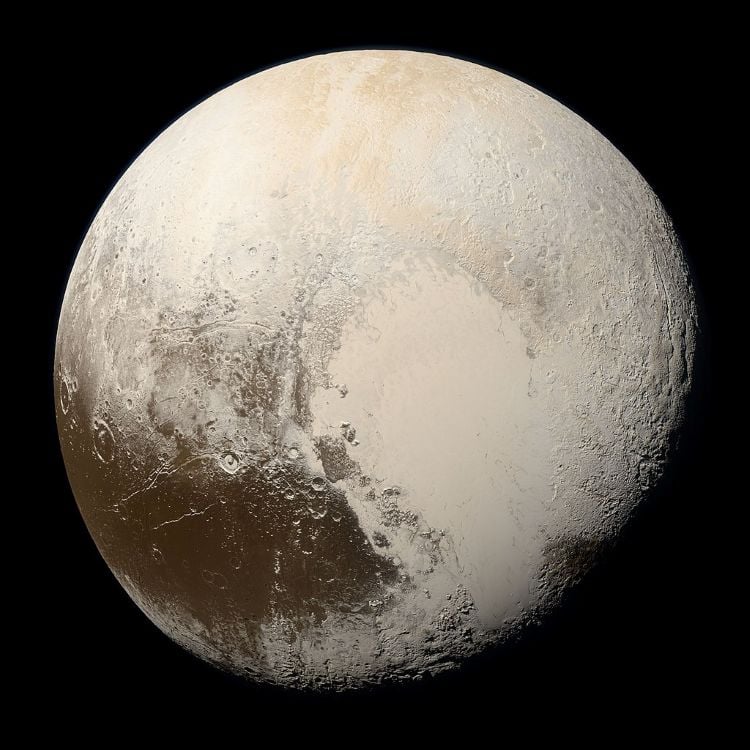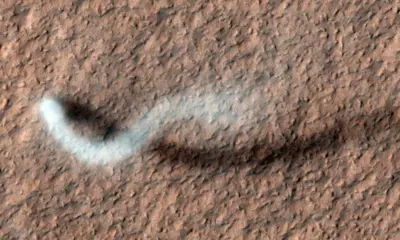Science
Scientists Uncover Cryovolcanism Evidence on Pluto’s Surface

Recent research published in *The Planetary Science Journal* has revealed potential evidence of cryovolcanism in the Kildaze caldera located within Pluto’s Hayabusa Terra region. This study aims to deepen understanding of the dwarf planet’s geological activity, particularly in light of its considerable distance from the Sun, which raises questions about the mechanisms driving such activity.
The research team utilized images captured by NASA’s New Horizons spacecraft, which conducted a flyby of Pluto in July 2015. By analyzing these images, the researchers compared Kildaze with other known cryovolcanic sites on Pluto, including Virgil Fossae and Viking Terra. They also drew comparisons to cryovolcanic analogs on Earth, such as the Yellowstone and Valles Caldera, as well as on Mars, specifically the pit craters found in Noctis Labyrinthus.
To gain further insights, the team employed digital elevation models and 3D visualizations to study the water ice composition within Kildaze. Their analysis concluded that the water ice could be several million years old, indicating a relatively young geological feature compared to Pluto’s overall age. The research suggests that Kildaze is a cryovolcano, possibly having ejected around 1,000 km3 of cryolava during its eruptions.
Cryovolcanism is characterized by eruptions of icy materials rather than molten rock, a concept that has been observed across various celestial bodies, including Ceres and Europa. The implications of this study are significant, considering Pluto’s position as the most distant known planet in the solar system. The traditional belief that solar energy drives geological activity is challenged by these findings, as Pluto’s cryovolcanism may stem from internal processes.
Ongoing debate among scientists centers around the sources of Pluto’s internal heating. Some suggest that tidal heating from interactions with its largest moon, Charon, could account for the warmth needed to sustain cryovolcanic activity. A study published in *Icarus* in 2022 proposed that the internal heat of Pluto is a result of its historical interactions with Charon, allowing it to retain heat long after its formation.
Since the New Horizons mission, which was the first and only spacecraft to visit Pluto, there have been discussions of future missions. Proposed projects include an orbiter-lander combination that could reach Pluto in approximately four years, significantly quicker than the nine years it took for New Horizons.
As scientists continue to analyze the data returned by New Horizons, they aim to uncover further secrets about Pluto’s geological activity and its cryovolcanic history. The question remains: what new insights will emerge in the coming years regarding Pluto’s geological processes? The exploration of this distant world continues to inspire curiosity and scientific inquiry.
-

 Technology5 months ago
Technology5 months agoDiscover the Top 10 Calorie Counting Apps of 2025
-

 Health2 months ago
Health2 months agoBella Hadid Shares Health Update After Treatment for Lyme Disease
-

 Health3 months ago
Health3 months agoErin Bates Shares Recovery Update Following Sepsis Complications
-

 Technology4 months ago
Technology4 months agoDiscover How to Reverse Image Search Using ChatGPT Effortlessly
-

 Technology1 month ago
Technology1 month agoDiscover 2025’s Top GPUs for Exceptional 4K Gaming Performance
-

 Technology2 months ago
Technology2 months agoElectric Moto Influencer Surronster Arrested in Tijuana
-

 Technology5 months ago
Technology5 months agoMeta Initiates $60B AI Data Center Expansion, Starting in Ohio
-

 Technology5 months ago
Technology5 months agoRecovering a Suspended TikTok Account: A Step-by-Step Guide
-

 Health4 months ago
Health4 months agoTested: Rab Firewall Mountain Jacket Survives Harsh Conditions
-

 Lifestyle5 months ago
Lifestyle5 months agoBelton Family Reunites After Daughter Survives Hill Country Floods
-

 Technology4 months ago
Technology4 months agoHarmonic Launches AI Chatbot App to Transform Mathematical Reasoning
-

 Technology3 months ago
Technology3 months agoUncovering the Top Five Most Challenging Motorcycles to Ride





















